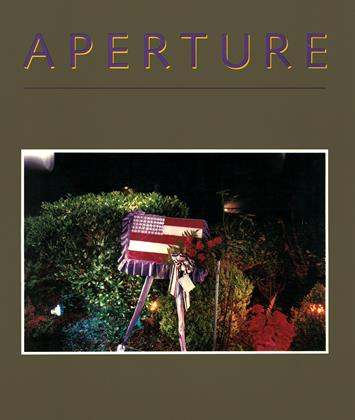Editor's Note
THE RECOGNITION AND ACCEPTANCE of color photography grew significantly with the Museum of Modern Art’s 1976 exhibition of work by William Eggleston. The notion that photography was a blackand-white medium was irreversibly challenged by that event. Eight years later Eggleston has exhibited the first dye-transfer prints from a series on Graceland, Elvis Presley’s mansion. He has returned from Berlin with another major body of work, further highlighting his astute perception and virtuoso use of color. Our enthusiastic response to these extremes of content formed the basis of this issue of Aperture. Eggleston’s work then created a context for an entire issue, which demanded color as the code. This enabled us to include work of diverse intentions, all of which emphatically stretched our awareness of color. The sequence that emerged corresponded with a sensibility that is particular and vital to our time.
The color of our time is the color that vibrates from television, billboards, and video screens. The color photograph carries the connotations of advertising and fashion, an association that has become a common part of artistic strategy. The veracity of photographic reality has been replaced by a feel for the illusions and facades of our environment. Current printing techniques and the manipulation they allow increase the possibility and intensity of those illusions. The medium has moved toward the chromatic field of paint with all its expressive potential.
Presley’s mansion and the Berlin Wall form the extremes of this issue, between which we feature William Christenberry’s theater of evil, the cinematic projections of Cindy Sherman’s theater of the “self,” and the artist as director in Lucas Samaras’s studio. There is both the irony of Joel Sternfeld’s landscapes and the immediacy of the surfaces of Luis Medina. The color forms both a subtle and an explosive language. It confirms the contemporary artifice of neon and tungsten, spotlight and searchlight.
THE EDITORS
Subscribers can unlock every article Aperture has ever published Subscribe Now
The Editors
-

Looking For Mr. Winogrand
Fall 1988 By Helen Gary Bishop, The Editors -
 Theme And Variations
Theme And VariationsThis Thing Called War And These People Called Photographers
Fall 2012 By Simon Norfolk, The Editors -
 People And Ideas
People And IdeasPresenting Photographers Past: An Editorial
Spring 1983 By The Editors -
 Editor's Note
Editor's NoteThe Human Street
Winter 1985 By The Editors -
 Note
NoteNote
Spring 2010 By The Editors -
 Editor's Note
Editor's Note“fashion”
Fall 2014 By The Editors
Editor's Note
-
 Editor's Note
Editor's NoteEditors' Note
Winter 2003 -
 Editor's Note
Editor's NoteWestern Spaces
Spring 1985 By The Editors -
 Editor's Note
Editor's NoteFiction And Metaphor
Summer 1986 By The Editors -
 Editor's Note
Editor's NoteThe Return Of The Hero
Spring 1988 By The Editors -
 Editor's Note
Editor's NoteCuriosity
Summer 2013 By The Editors -
 Editor's Note
Editor's NoteCosmologies
Fall 2021 By The Editors








